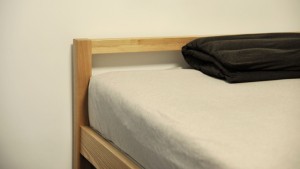"Wacky" dreams are healthy dreams
Steve Woodward, a psychiatrist with the National Center for PTSD in Menlo Park says the hallmark of a healthy dream is that it seems kind of random.
"They’re wacky," says Woodward. "They associate things that are not normally associated."
PTSD dreams, in contrast, are like a broken record: the same, real-life event, played over and over again. Woodward says he's seen patients haunted by the same true-to-life nightmare for twenty years.
The question scientists had was: why? Why can't people with PTSD sleep normally?
Healthy sleep as therapy
Matthew Walker is a sleep researcher at the University of California, Berkeley. One of his particular interests is in rapid eye movement, or REM. It’s the stage of sleep where a lot of dreaming occurs.
REM sleep is also the only time of the day that the brain stops producing a kind of adrenaline called norepinephrine. That fact struck Walker as an intriguing mystery. Why would rapid eye movement sleep suppress this neurochemical, he wondered. Is there any function to that?
What Walker and his colleagues found is that in healthy people, REM sleep is kind of like therapy. It's an adrenaline-free environment where the brain can process its memories while stripping away their sharp, emotional edges.
"When you come back the next day," says Walker, "yes, you can better recollect [the memory]. But also, it doesn’t trigger that same visceral reaction that you had at the time of learning."
Emotions are useful, says Walker, because they show us what really matters to us. But it's not useful to hold onto what he calls the "emotional blanket," that accompanied the original event. The emotions, he says, "have done their job. Now it’s time to hold on to the information of that memory, but let go of the emotion."
"Broken" REM sleep
Walker believes that in many people who have PTSD, REM sleep is broken. Something about PTSD either causes the brain to be overly sensitive to norepinephrine, or forces the brain to create too much of it. The brain's adrenaline system is effectively out of whack.
As a result, REM sleep is no longer theraputic. The PTSD brain can't process tough memories, so it just cycles through them, again and again.
Which begs a question: What if you could change that? What if you could make the adrenaline go away?
An old drug finds a new role
Murray Raskind directs Mental Health Services for the Department of Veterans Affairs Puget Sound Health Care System. About a decade ago, he became interested in a drug called Prazosin, which was traditionally used to treat high blood pressure.
Prazosin can be bought generically for about ten cents a pill. It can have the side effect of making people dizzy. For the most part, it's been supplanted by other, more recent hypertension drugs, whose effects last longer. But Prazosin turned out to have another use: It makes the PTSD brain less receptive to adrenaline.
As a result, as Raskind discovered, prazosin can change the way those patients dream.
Raskind tells the story of one of the first vets he ever treated with prazosin, a veteran Raskind calls Charles, who spent 13 months in a combat infantry unit in Vietnam.
What haunted Charles was one specific event from his service: Under an ambush by Vietcong forces, Charles and a fellow soldier, his closest friend, found themselves trapped in a landing zone in the jungle. Charles watched as his friend was killed by a mortar round. Fragments of the round pierced Charles' right knee, leaving him unable to run. Charles was saved at the last minute by troops in a Huey helicopter, just as Vietcong forces climbed through the wire to reach him.
"This near-death experience," says Raskind, "and even more distressing, the death of his best friend, whose death he felt he was unable to prevent, haunted him most nights, every week, year in and year out."
After a few weeks of Prazosin, Charles came in for a follow-up appointment. He told Raskind that he didn't think the drug was working. He was still dreaming, just about something else.
According to Raskind, the dream went like this: "I'm in my fifth-grade classroom. And there’s a test, and if I don’t pass the test, I’m not gonna be promoted to the next grade. And I never even got the assignment!”
It was the stress dream, says Raskind, of a healthy brain, trying to work things out. "I said 'Charles, that’s MY nightmare!'" Raskind recalls.
So far the studies on prazosin have been small (abstracts can be found online, here and here and here – as well as of a 2008 round-up of data, here) but promising in decreasing nightmares and helping people sleep longer.
Other small studies involving non-combat PTSD – people who had been victims of crime and sexual assault, as well as refugees – found an improvement in the quality of their dreams, and overall sleep, as well.
The Department of Veterans Affairs is undergoing its own study on prazosin in PTSD, which is taking part in 13 medical centers across the country. But is already prescribing the drug to about 15 percent of its PTSD patients -- about 70,000 people.
Murray Raskind, for one, would like to see that number rise.

